The C&S Coal Chutes: Pine, Como, Dickey, Pitkin and almost Breckenridge
Posted by Jim Courtney on Dec 17, 2015; 1:31am
URL: http://c-sng-discussion-forum.254.s1.nabble.com/The-C-S-Coal-Chutes-Pine-Como-Dickey-Pitkin-and-almost-Breckenridge-tp4269.html
I have been drawing track plans, for the past several months, for the after-retirement Sn3 layout I hope to build of the C&S, set in the summer of 1909. Every time I get out my T-square and compass, I’m always drawn back to Platte Canon in general and the town of Pine in specific.
Located about half way between Denver and Como, Pine (AKA Pine Grove) was an important coaling and helper station between the two terminals. The walls of Platte Canon were steep to the east of Pine, but grades generally less than 3%. To the west of Pine, the Canon became wider, in some places an open valley, but the grades were steeper, between 3.3% and 4.0%. From the earliest days on the DSP&P, locomotives were coaled at Pine and one or more helpers were added to west bound freights.
The station always had a wye for turning helpers, with the depot on the main within the legs of the wye. In the early years, long coaling platforms to the south of the main allowed for coaling of locomotives by hand. In the 20th century there was one of the signature C&S coaling trestles with chutes, to allow mechanical gravity coaling of motive power, just to the south of the mainline opposite the depot. There was a passing / house track to the north of the mainline, in front of the depot, and a long storage track to the south of the coaling trestle for storage of cars of company coal. This view of Pine from a hill to the northwest, taken in the late 1920s, gives a good overview of the station:
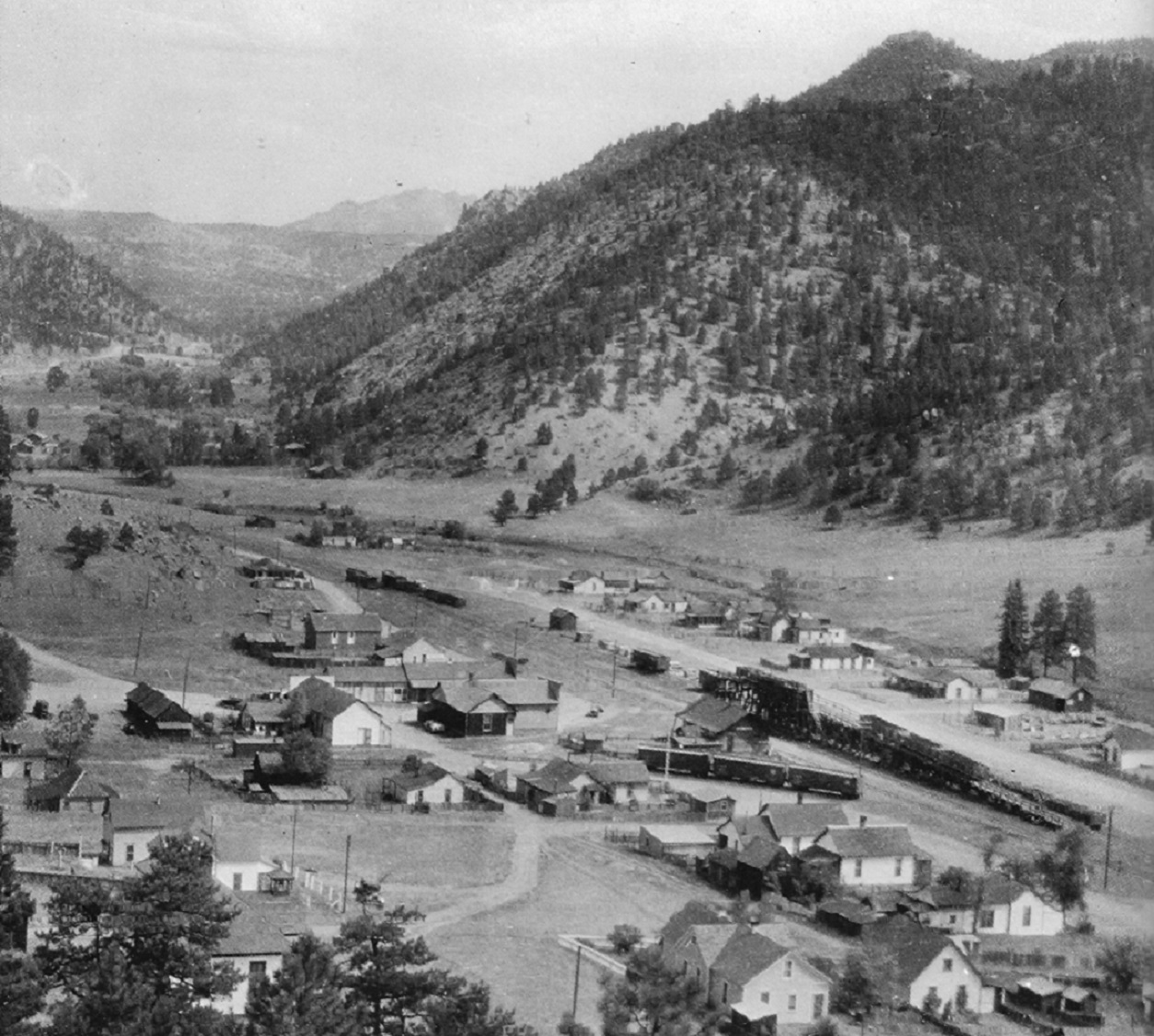
Sanborn Postcard, Colorado Railroad Museum Collection, in Digerness, The Mineral Belt I, page 172.

Joe Crea track diagram, from “Slim Gauge News”
All-in-all, an attractive C&S station for modeling purposes. Curiously, there was never a water tank at Pine to allow watering all those helpers, the nearest tank being at Crossons five miles to the west.
Obviously the centerpiece for any Sn3 model would be the coaling trestle:
http://digital.denverlibrary.org/cdm/singleitem/collection/p15330coll22/id/12030/rec/704
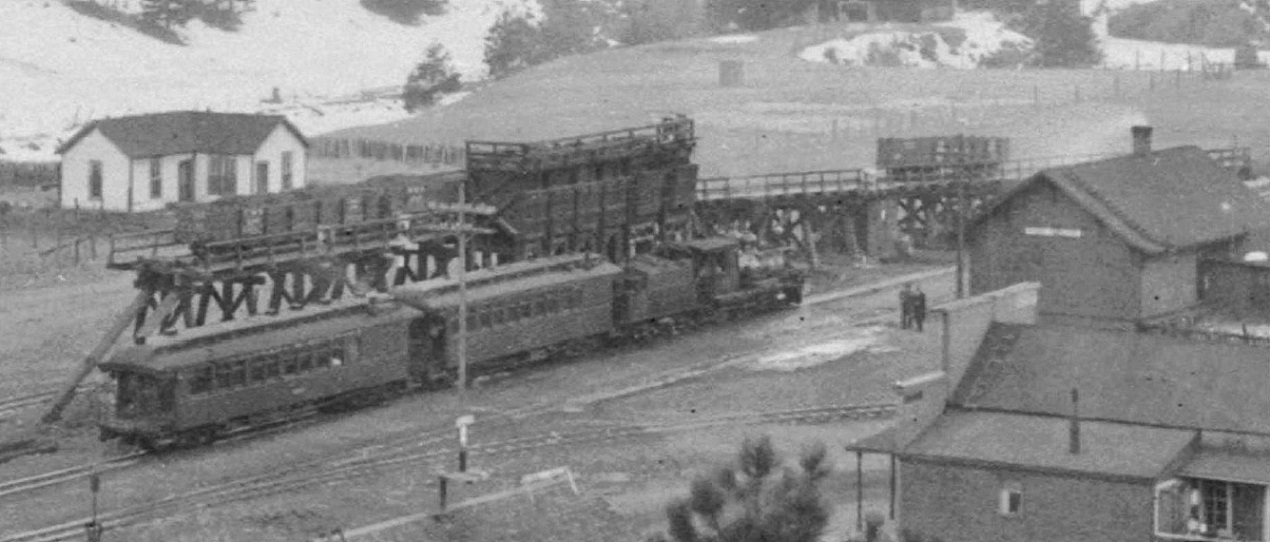
Denver Water Board special, 1929.
Fortunately, Joe Crea published drawings of the C&S coaling trestles at Pine, Pitkin and Dickey back in the late 1970s in an issue of Bob Brown's Slim Gauge News, the predecessor to the Gazette. The notes state that Joe redrew the plans from dimensions and sketches by Elwood Bell. Since the drawings referenced the 6-bin structures at Pine and Pitkin and the 12-bin structure at Dickey (6-bin chutes on either side of the trestle, serving two tracks), I jumped to the conclusion thirty-some-odd years ago that all the structures were built at the same time, in 1901-1902, to the same general plans, as a property improvement by the new C&S management.
The Pine coal chute differed from both Pitkin and Dickey in that it had four chutes that were similar in size to the latter’s chutes, but the two chutes on the west end of the bin structure were larger. Joe detailed these two west end chutes in a side bar on his drawings. I again jumped to the conclusion that the chutes at Pine were built with six identical bins c1901-1902, and that the two westward chutes were enlarged, sometime in the 1920s, likely to accommodate the large coal capacity of the newly arrived B-4-F class 2-8-0s from the DB&W.
These two photographs illustrate the difference in size of the bins / chutes at Pine:
http://digital.denverlibrary.org/cdm/singleitem/collection/p15330coll22/id/42241/rec/11
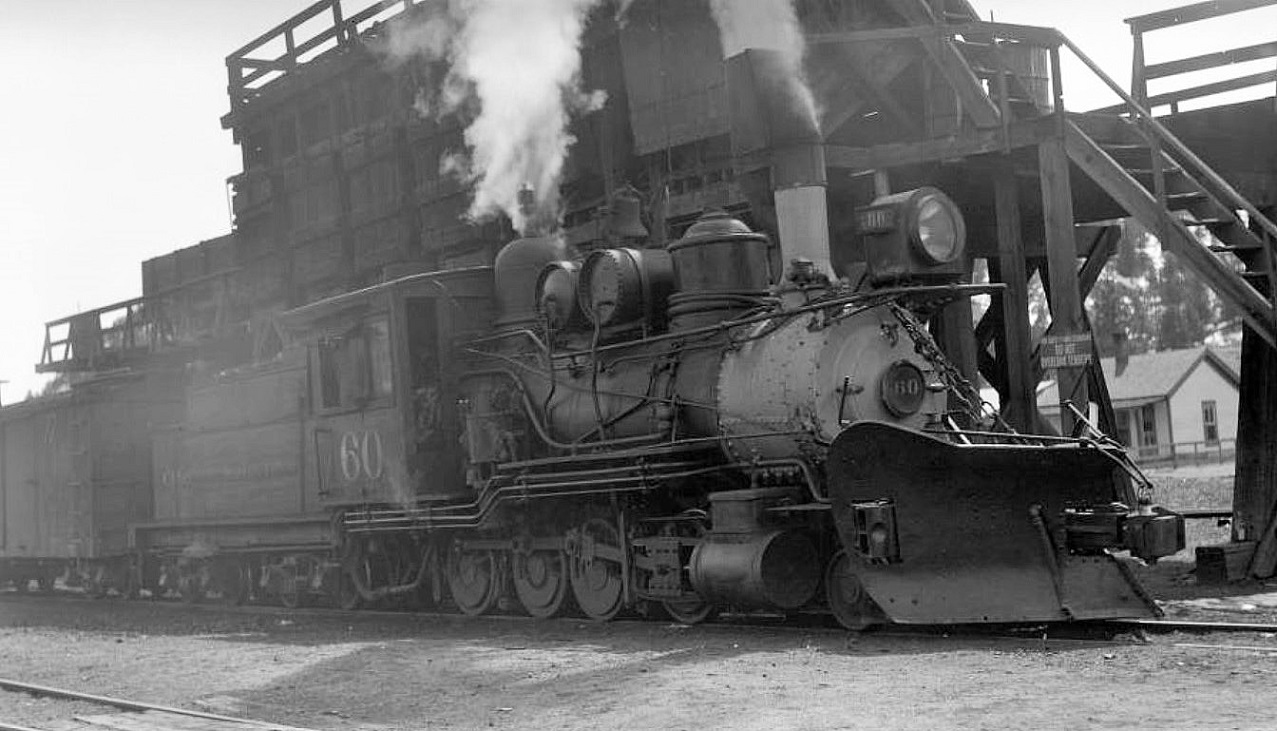
Otto Perry photo of C&S 60 at the chutes with the last passenger train to Leadville, April 9, 1937.

Late 1920s-early 1930s. Jefferson County Historic Society, #169. In the Klingers’ Platte Canon Memories . . . , page 119.
This explanation of the chute arrangement at Pine made sense to me, a logical explanation of an oddity. Unfortunately, as we shall see, the explanation was pure fantasy, the truth far more complicated.
A couple of months ago, I enlarged this DPL photo by McClure, from the mid to late 1890s to study the structures behind the railroad tracks at Pine. I noticed something in the enlargement that had not been apparent in the small reproductions of this photo in my books:
http://cdm16079.contentdm.oclc.org/cdm/singleitem/collection/p15330coll21/id/3681/rec/5

At the right frame it is obvious that the track on which the two coaches are spotted begins to climb up the west end of the coaling trestle grade. So, the Pine coal trestle and chutes had to be in place by the mid to late 1890s, during DL&G days. So, just when was the coal trestle at Pine built and who built it??
Curious, I took out my copy of the Old Testament to see what Mac Poor had to say on the subject. Chapter XXII of Denver South Park & Pacific is a mile-by-mile station list of the entire road. The entry for Pine Grove on page 419 mentions the depot dimensions and the fact that there was a “coal chute, 3 shovelers and an engine hostler”, but doesn’t address when the coal chute was built. So, I turned to the facilities list at Como, to see when the 8 bin covered structure there was built, perhaps a contemporary of that at Pine. But to my dismay, Mac Poor lists every conceivable railroad structure at the division point, except the coal chutes!!
Turning to Poor’s descriptions of Pitkin and Dickey, some of my early assumptions were validated:
Pitkin: “In 1901, the railroad built a coal chute at the cost of $2,717.38.”
Dickey: “The Colorado & Southern built a coal chute here in 1902 at the cost of $4,397.82." (Evidently 12 bins didn’t cost twice as much as 6 bins.)
But I still didn’t have any idea when the Pine coal trestle was built. Then I recalled that another coal chute, never photographed to my knowledge, existed at Schwanders. Mac Poor’s entry for that station was astounding:
“At various times the railroad facilities consisted of a 47,500 gallon wood water tank, an eight-pocket coal chute, a wye and 2,634 feet of side track. . . Old Union Pacific records tell that the coal chute at Schwanders was built in 1884 at the cost of $2,796.36. It was removed in May, 1894.”
Built in 1884!! That means any number of Congdon stacked Mason, Baldwin, Brooks and Cooke locomotives took coal there! And eight chutes? Were there eight chutes in a row serving one track or a double four-pocket set of bins like the double six-pocket chutes later built at Dickey? If eight-bins in a row, was the entire structure covered like the structure at Como? Was the coaling trestle at Como a contemporary, also built in 1884?
I found no further answers in Poor’s book, so went back to the book shelf and took out the New Testament to see what the apostles Chappell, Richardson and Hauck had to say. CRA 12, The South Park Line, A Concise History, has no station list like that of the prophet Poor. So I just began to reread the book. And there, in Chapter 4, “Colorado & Southern: An Operations Baedecker”, I found this entry by Bob Richardson: “The DL&G reported, in its inventory for the year 1892, . . . a four-pocket coal chute at Pine Grove.”
Four-pockets?? And in place as early as 1892?? Wait, eight pockets at Schwanders, four pockets at Pine Grove—could the Pine Grove structure also date to 1884?? (I mean 4 does go into 8 evenly! That must be some kind of proof, right?).
The only 1880s photo of Pine that I’ve ever seen is this one:

Richard Ronzio Collection, in Digerness, Mineral Belt II, page 50.
The view is pretty much from the same hill side as the late 1920s view in the first photo above. In the bottom right corner two helper engines are spotted on the west leg of the wye, behind the depot. An enlargement of my best scan from the book is below:
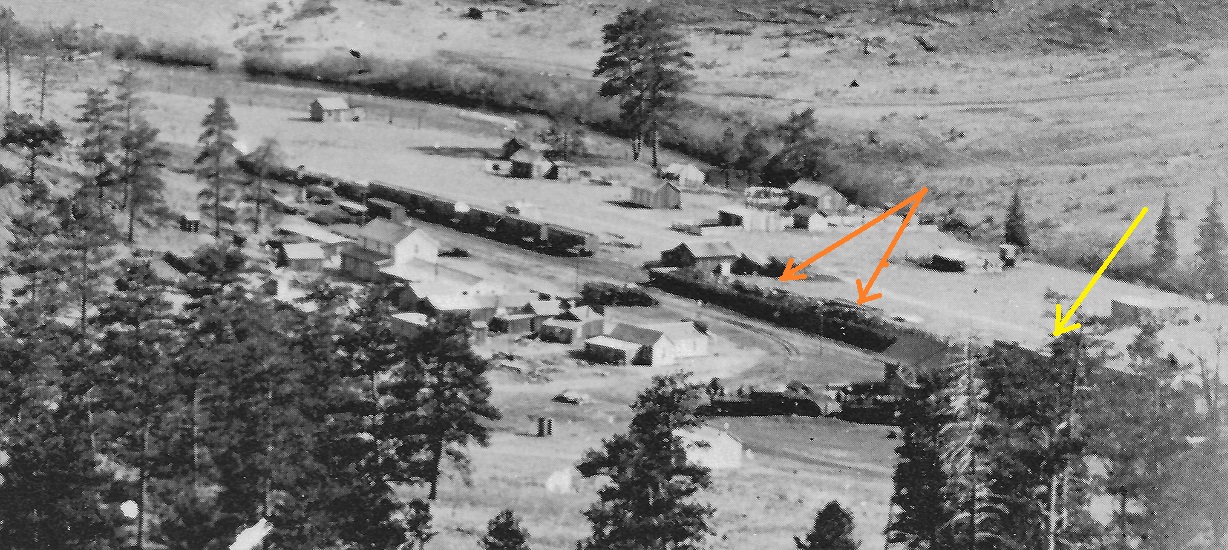
The engine to the left clearly has a Congdon stack, the one behind it appears to have a UP diamond stack. I can’t make out any large 1885 numbers on the tenders, but they are in shadow. My best guess is that the photo dates from 1885-1886. The long coal bins (orange arrows) are visible south of the main to the east of the depot. Some kind of structure appears, obscured by trees, opposite and to the west of the depot, where the coal chutes would later stand (yellow arrow). I cannot tell if the coaling chute is present in the photo or not. Could be.
So, if the coal chutes at Pine were there as early as 1892 (possibly as early as 1884) and were built with four pockets per the Union Pacific records, it means that the two additional large chutes were not modifications of the chutes, but additions to the chutes. But when were they added? Were they added in 1901-1902 when the six-pocket chutes were built at Pitkin and Dickey? Or later, in the early to mid-1920s to accommodate the DB&W engines, as I had earlier surmised? More to the point, if I build a 1909 model, how many chutes do I build?
The Klingers’ book does have some first decade photos of Pine. This photo of Pine from the South is dated "early 1900s”, perhaps as close as I will get:
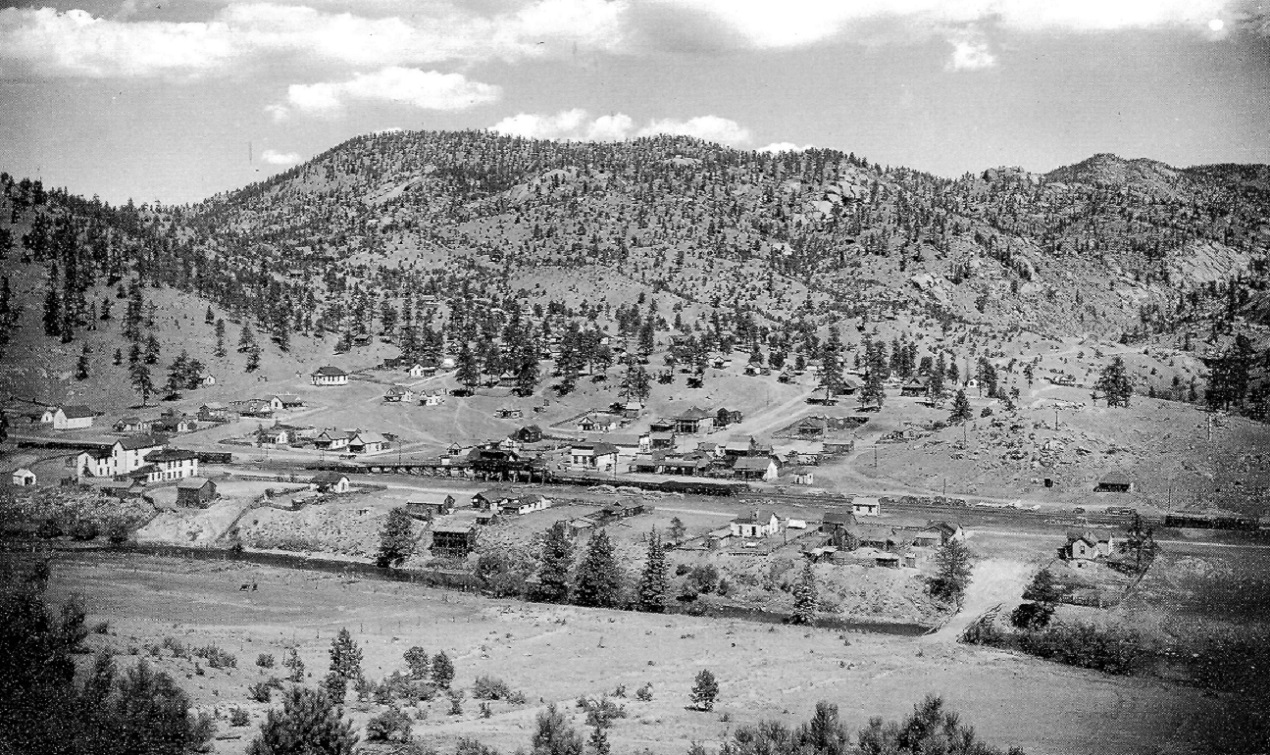
John Halliman Collection, in the Klingers’ Platte Canon Memories . . . , page 115.
The coaling trestle is different from the 1920s-1930s photos at the beginning of the post. The trestle beyond the coal bins is shorter than the later trestle, only three stringer spans between bents not four. And the two heavy diagonal end braces haven’t been added. Enlarging the photo:

The coal bins are the odd black rectangle that partially obscures the depot roof. The length of the black rectangle as just about the length of two of the trestle stringer spans or about 32 feet per Joe Crea’s plans. That would correspond to, well, four bins per his drawings. So in 1909, it is likely the bins had not yet been rebuilt, and were still four in number.
And then there is this DPL photo accredited to McClure, and probably around 1908-1910:
http://digital.denverlibrary.org/cdm/singleitem/collection/p15330coll22/id/77809/rec/13
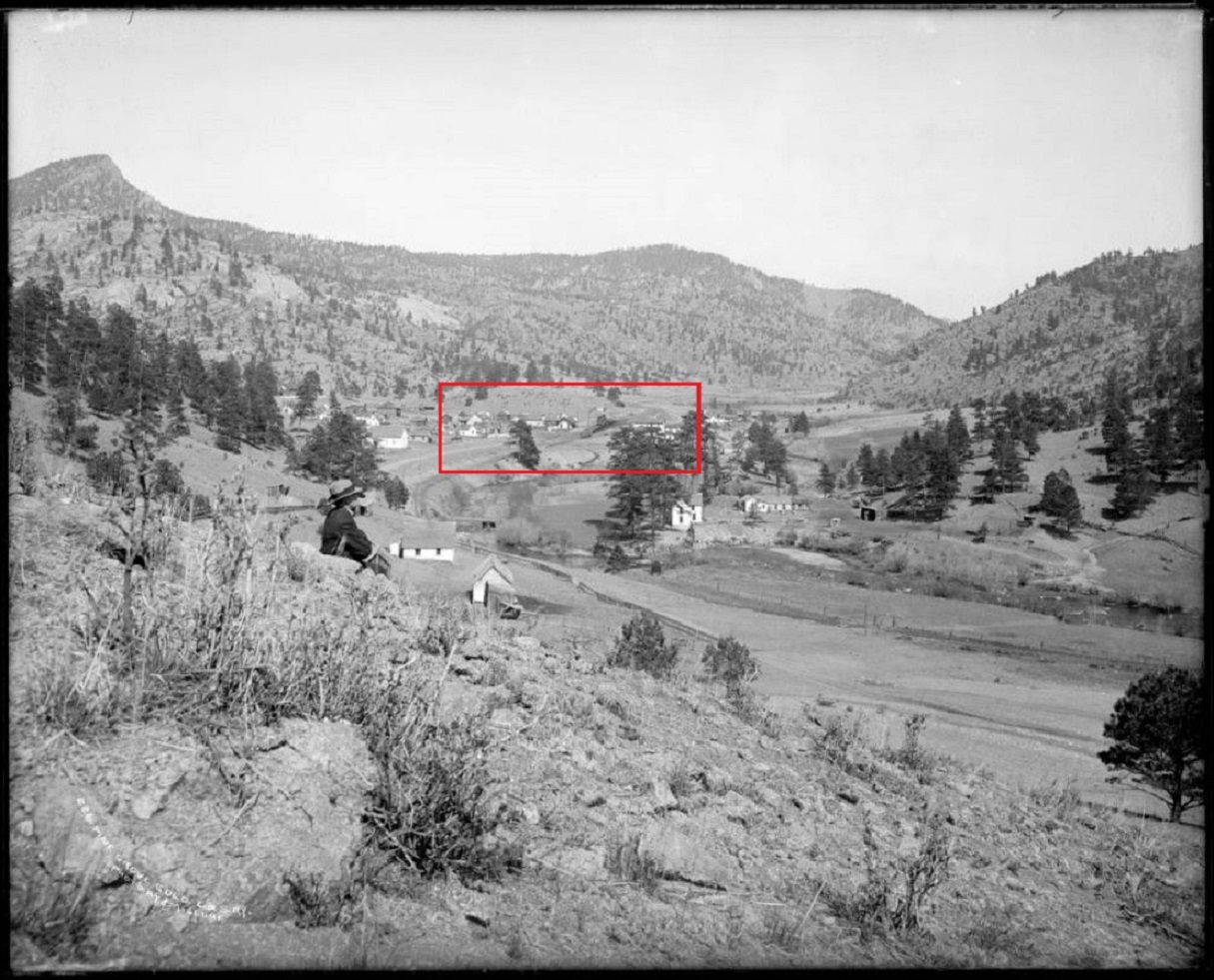
If you enlarge the outlined portion of the photo, the odd black rectangle over the coal bins in the previous photo is explained—it’s a shadow:
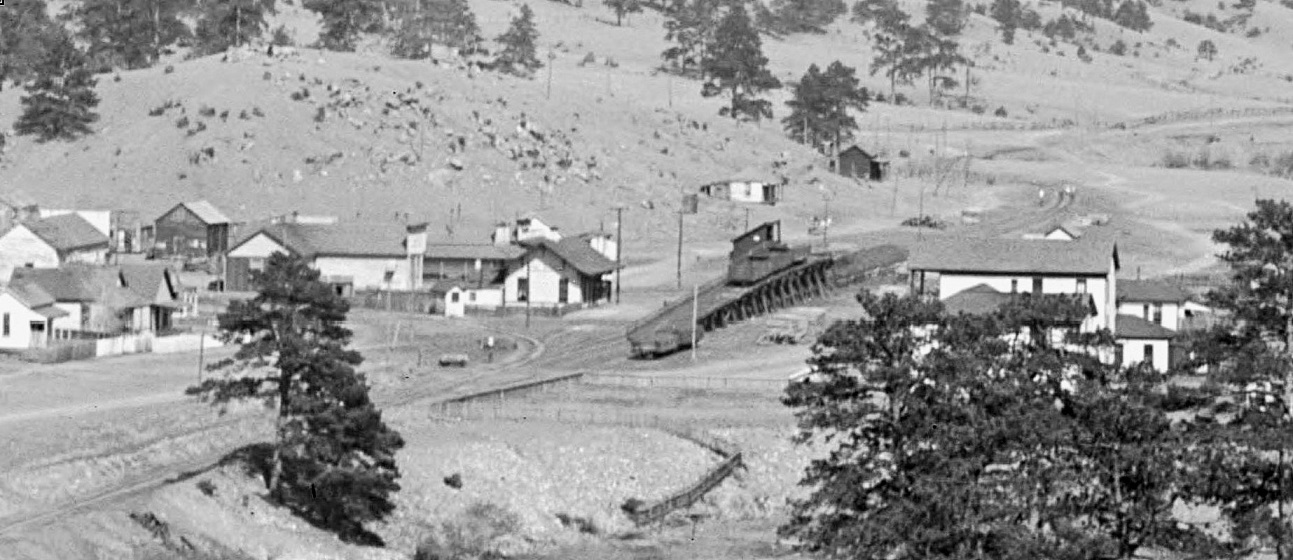
The Pine coal chutes had a covered bin storage area, not like at Como where both the bins and the unloading section of trestle were covered, but just the bins. It reminds me of the covered bins at the coaling station at Vance Junction on the Rio Grande Southern. The long coaling platform, full of storage coal, still exists to the east of the coaling trestle. The depot appears freshly painted in the light and dark trim scheme.
So the next question that comes up is when was the roof of the coaling bins removed and the extra chutes added? Early 1920s or earlier?
This photo seems later, perhaps 1915-1920, as some structures are missing, or have additions and are generally in less repair:
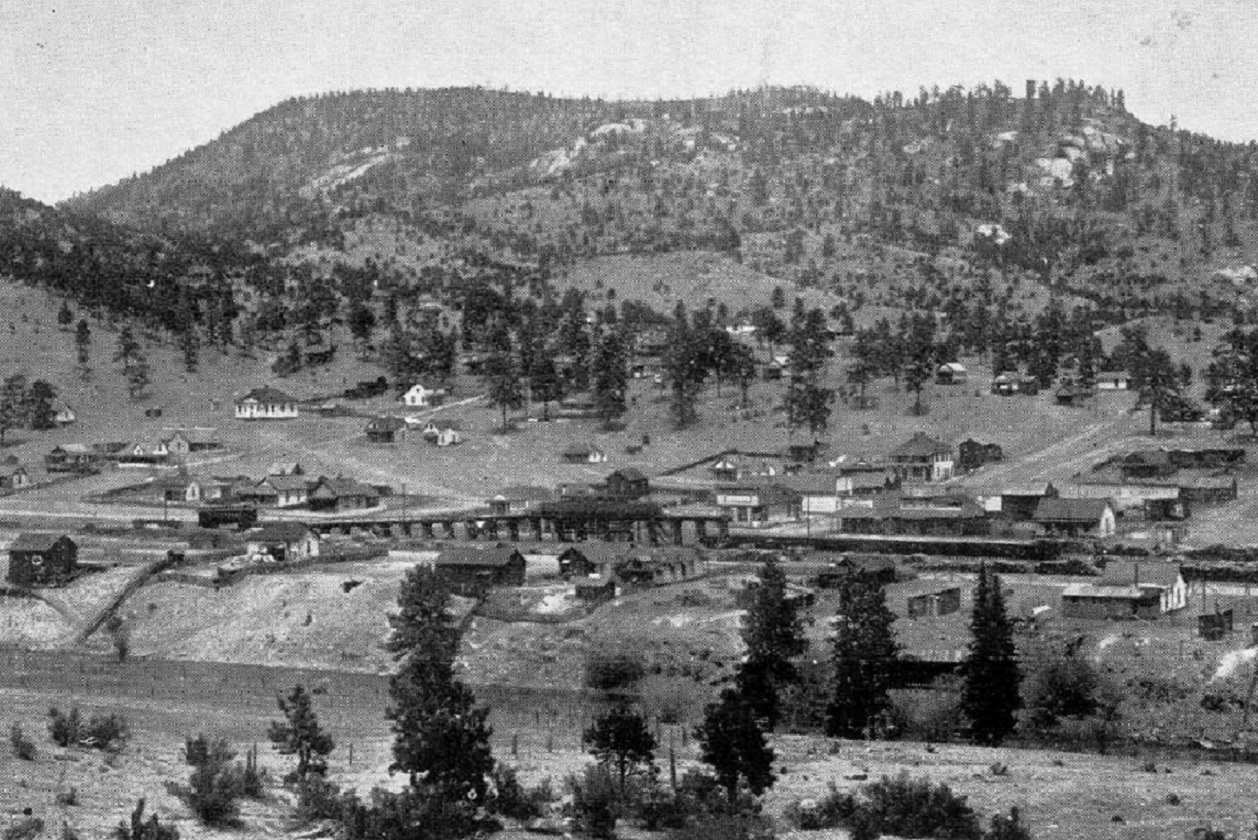
The trestle has two coal cars in front of the bins, but the dark rectangular shadow from the roof of the structure seems to be gone. And it almost looks like the later retaining rails are in place.
This 1920s photo of the Pine depot does show the shadow of the retaining rails from the coal bins, implying the roof of the structure is gone:
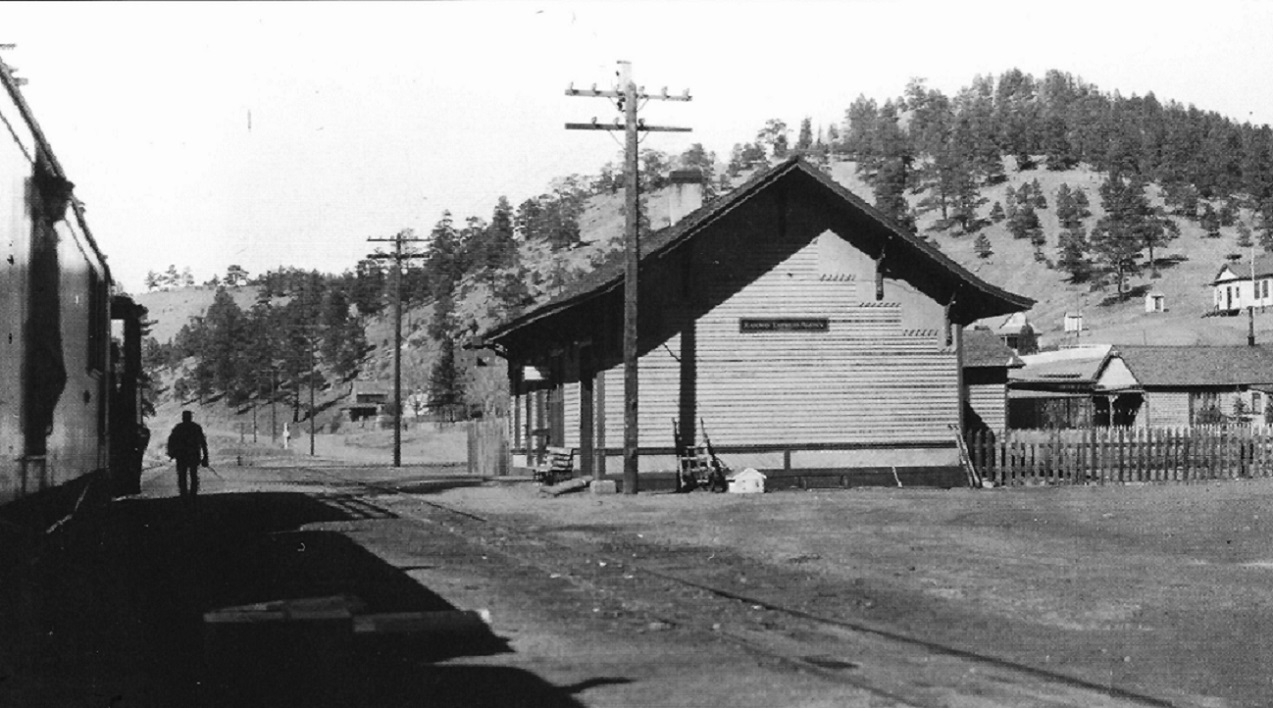
Colorado Railroad Museum Collection, in the Klingers’ Platte Canon Memories . . . , page 119.
By the way, has anyone noticed that the Pine depot is a near twin of the Fairplay depot?
I couldn’t find any more photos that shed light on the coaling chutes details, but there is one more interesting photo to include. When the C&S ran day picnic excursions to Dome Rock and Crystal Lake, after unloading the picnickers, the engines would move the empty passenger cars on west to Pine. There the engine would be turned and coaled and the passenger/excursion cars set out until late afternoon, when the train would head back east to return the tourists to their Denver hotels. That likely explains the passenger cars that show up in early photos of Pine. I think Chris may have already posted this enlargement, but it is evident that the coal trestle at Pine wasn’t just for coal cars:
http://digital.denverlibrary.org/cdm/singleitem/collection/p15330coll22/id/12029/rec/5
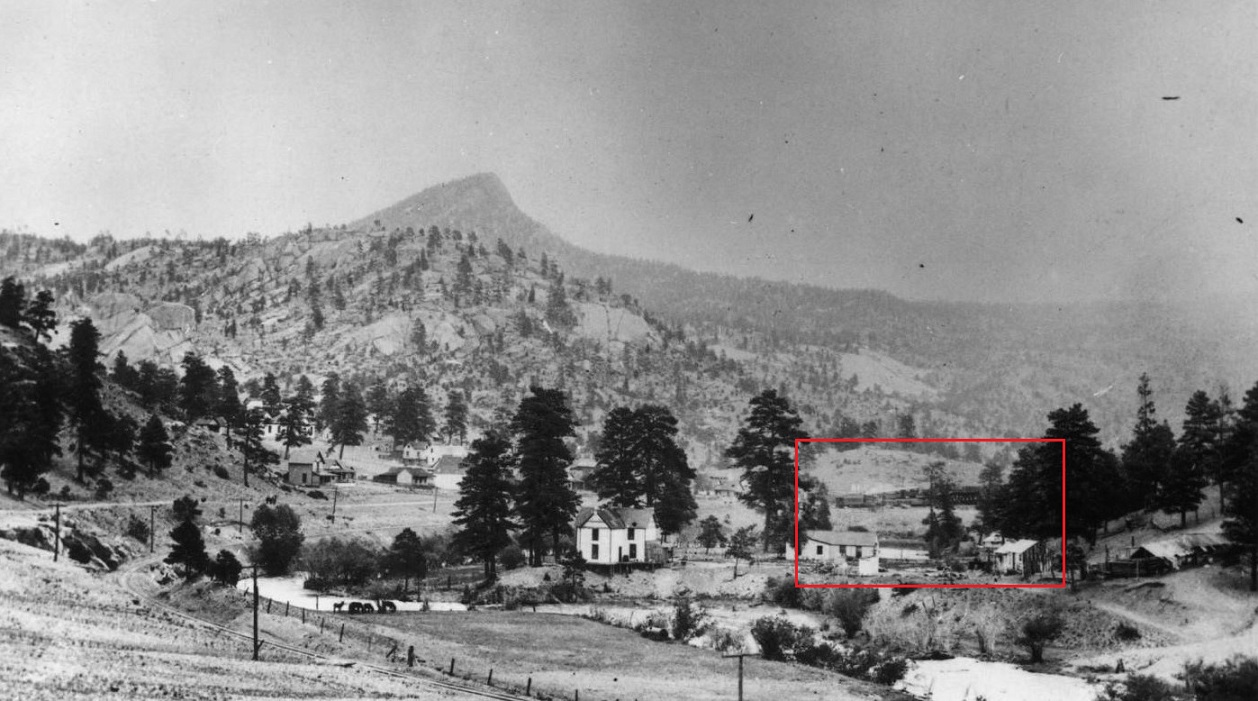

So, questions for The Forum:
1. Does anyone know of written records of when the coal chutes at Pine were built? And the chutes at Como for that matter?
2. Are there any photos of the Pine chutes clearly showing only four chutes?
3. Any photos of the fabled coaling chutes at Schwanders?
4. Does anyone know definitively when the extra two large chutes were added to the Pine coaling structure?
5. Are my conclusions valid, or am I being delusional and making stuff up?
Jim in the Wet Pacific Northwest
URL: http://c-sng-discussion-forum.254.s1.nabble.com/The-C-S-Coal-Chutes-Pine-Como-Dickey-Pitkin-and-almost-Breckenridge-tp4269.html
I have been drawing track plans, for the past several months, for the after-retirement Sn3 layout I hope to build of the C&S, set in the summer of 1909. Every time I get out my T-square and compass, I’m always drawn back to Platte Canon in general and the town of Pine in specific.
Located about half way between Denver and Como, Pine (AKA Pine Grove) was an important coaling and helper station between the two terminals. The walls of Platte Canon were steep to the east of Pine, but grades generally less than 3%. To the west of Pine, the Canon became wider, in some places an open valley, but the grades were steeper, between 3.3% and 4.0%. From the earliest days on the DSP&P, locomotives were coaled at Pine and one or more helpers were added to west bound freights.
The station always had a wye for turning helpers, with the depot on the main within the legs of the wye. In the early years, long coaling platforms to the south of the main allowed for coaling of locomotives by hand. In the 20th century there was one of the signature C&S coaling trestles with chutes, to allow mechanical gravity coaling of motive power, just to the south of the mainline opposite the depot. There was a passing / house track to the north of the mainline, in front of the depot, and a long storage track to the south of the coaling trestle for storage of cars of company coal. This view of Pine from a hill to the northwest, taken in the late 1920s, gives a good overview of the station:

Sanborn Postcard, Colorado Railroad Museum Collection, in Digerness, The Mineral Belt I, page 172.

Joe Crea track diagram, from “Slim Gauge News”
All-in-all, an attractive C&S station for modeling purposes. Curiously, there was never a water tank at Pine to allow watering all those helpers, the nearest tank being at Crossons five miles to the west.
Obviously the centerpiece for any Sn3 model would be the coaling trestle:
http://digital.denverlibrary.org/cdm/singleitem/collection/p15330coll22/id/12030/rec/704

Denver Water Board special, 1929.
Fortunately, Joe Crea published drawings of the C&S coaling trestles at Pine, Pitkin and Dickey back in the late 1970s in an issue of Bob Brown's Slim Gauge News, the predecessor to the Gazette. The notes state that Joe redrew the plans from dimensions and sketches by Elwood Bell. Since the drawings referenced the 6-bin structures at Pine and Pitkin and the 12-bin structure at Dickey (6-bin chutes on either side of the trestle, serving two tracks), I jumped to the conclusion thirty-some-odd years ago that all the structures were built at the same time, in 1901-1902, to the same general plans, as a property improvement by the new C&S management.
The Pine coal chute differed from both Pitkin and Dickey in that it had four chutes that were similar in size to the latter’s chutes, but the two chutes on the west end of the bin structure were larger. Joe detailed these two west end chutes in a side bar on his drawings. I again jumped to the conclusion that the chutes at Pine were built with six identical bins c1901-1902, and that the two westward chutes were enlarged, sometime in the 1920s, likely to accommodate the large coal capacity of the newly arrived B-4-F class 2-8-0s from the DB&W.
These two photographs illustrate the difference in size of the bins / chutes at Pine:
http://digital.denverlibrary.org/cdm/singleitem/collection/p15330coll22/id/42241/rec/11

Otto Perry photo of C&S 60 at the chutes with the last passenger train to Leadville, April 9, 1937.

Late 1920s-early 1930s. Jefferson County Historic Society, #169. In the Klingers’ Platte Canon Memories . . . , page 119.
This explanation of the chute arrangement at Pine made sense to me, a logical explanation of an oddity. Unfortunately, as we shall see, the explanation was pure fantasy, the truth far more complicated.
A couple of months ago, I enlarged this DPL photo by McClure, from the mid to late 1890s to study the structures behind the railroad tracks at Pine. I noticed something in the enlargement that had not been apparent in the small reproductions of this photo in my books:
http://cdm16079.contentdm.oclc.org/cdm/singleitem/collection/p15330coll21/id/3681/rec/5

At the right frame it is obvious that the track on which the two coaches are spotted begins to climb up the west end of the coaling trestle grade. So, the Pine coal trestle and chutes had to be in place by the mid to late 1890s, during DL&G days. So, just when was the coal trestle at Pine built and who built it??
Curious, I took out my copy of the Old Testament to see what Mac Poor had to say on the subject. Chapter XXII of Denver South Park & Pacific is a mile-by-mile station list of the entire road. The entry for Pine Grove on page 419 mentions the depot dimensions and the fact that there was a “coal chute, 3 shovelers and an engine hostler”, but doesn’t address when the coal chute was built. So, I turned to the facilities list at Como, to see when the 8 bin covered structure there was built, perhaps a contemporary of that at Pine. But to my dismay, Mac Poor lists every conceivable railroad structure at the division point, except the coal chutes!!
Turning to Poor’s descriptions of Pitkin and Dickey, some of my early assumptions were validated:
Pitkin: “In 1901, the railroad built a coal chute at the cost of $2,717.38.”
Dickey: “The Colorado & Southern built a coal chute here in 1902 at the cost of $4,397.82." (Evidently 12 bins didn’t cost twice as much as 6 bins.)
But I still didn’t have any idea when the Pine coal trestle was built. Then I recalled that another coal chute, never photographed to my knowledge, existed at Schwanders. Mac Poor’s entry for that station was astounding:
“At various times the railroad facilities consisted of a 47,500 gallon wood water tank, an eight-pocket coal chute, a wye and 2,634 feet of side track. . . Old Union Pacific records tell that the coal chute at Schwanders was built in 1884 at the cost of $2,796.36. It was removed in May, 1894.”
Built in 1884!! That means any number of Congdon stacked Mason, Baldwin, Brooks and Cooke locomotives took coal there! And eight chutes? Were there eight chutes in a row serving one track or a double four-pocket set of bins like the double six-pocket chutes later built at Dickey? If eight-bins in a row, was the entire structure covered like the structure at Como? Was the coaling trestle at Como a contemporary, also built in 1884?
I found no further answers in Poor’s book, so went back to the book shelf and took out the New Testament to see what the apostles Chappell, Richardson and Hauck had to say. CRA 12, The South Park Line, A Concise History, has no station list like that of the prophet Poor. So I just began to reread the book. And there, in Chapter 4, “Colorado & Southern: An Operations Baedecker”, I found this entry by Bob Richardson: “The DL&G reported, in its inventory for the year 1892, . . . a four-pocket coal chute at Pine Grove.”
Four-pockets?? And in place as early as 1892?? Wait, eight pockets at Schwanders, four pockets at Pine Grove—could the Pine Grove structure also date to 1884?? (I mean 4 does go into 8 evenly! That must be some kind of proof, right?).
The only 1880s photo of Pine that I’ve ever seen is this one:

Richard Ronzio Collection, in Digerness, Mineral Belt II, page 50.
The view is pretty much from the same hill side as the late 1920s view in the first photo above. In the bottom right corner two helper engines are spotted on the west leg of the wye, behind the depot. An enlargement of my best scan from the book is below:

The engine to the left clearly has a Congdon stack, the one behind it appears to have a UP diamond stack. I can’t make out any large 1885 numbers on the tenders, but they are in shadow. My best guess is that the photo dates from 1885-1886. The long coal bins (orange arrows) are visible south of the main to the east of the depot. Some kind of structure appears, obscured by trees, opposite and to the west of the depot, where the coal chutes would later stand (yellow arrow). I cannot tell if the coaling chute is present in the photo or not. Could be.
So, if the coal chutes at Pine were there as early as 1892 (possibly as early as 1884) and were built with four pockets per the Union Pacific records, it means that the two additional large chutes were not modifications of the chutes, but additions to the chutes. But when were they added? Were they added in 1901-1902 when the six-pocket chutes were built at Pitkin and Dickey? Or later, in the early to mid-1920s to accommodate the DB&W engines, as I had earlier surmised? More to the point, if I build a 1909 model, how many chutes do I build?
The Klingers’ book does have some first decade photos of Pine. This photo of Pine from the South is dated "early 1900s”, perhaps as close as I will get:

John Halliman Collection, in the Klingers’ Platte Canon Memories . . . , page 115.
The coaling trestle is different from the 1920s-1930s photos at the beginning of the post. The trestle beyond the coal bins is shorter than the later trestle, only three stringer spans between bents not four. And the two heavy diagonal end braces haven’t been added. Enlarging the photo:

The coal bins are the odd black rectangle that partially obscures the depot roof. The length of the black rectangle as just about the length of two of the trestle stringer spans or about 32 feet per Joe Crea’s plans. That would correspond to, well, four bins per his drawings. So in 1909, it is likely the bins had not yet been rebuilt, and were still four in number.
And then there is this DPL photo accredited to McClure, and probably around 1908-1910:
http://digital.denverlibrary.org/cdm/singleitem/collection/p15330coll22/id/77809/rec/13

If you enlarge the outlined portion of the photo, the odd black rectangle over the coal bins in the previous photo is explained—it’s a shadow:

The Pine coal chutes had a covered bin storage area, not like at Como where both the bins and the unloading section of trestle were covered, but just the bins. It reminds me of the covered bins at the coaling station at Vance Junction on the Rio Grande Southern. The long coaling platform, full of storage coal, still exists to the east of the coaling trestle. The depot appears freshly painted in the light and dark trim scheme.
So the next question that comes up is when was the roof of the coaling bins removed and the extra chutes added? Early 1920s or earlier?
This photo seems later, perhaps 1915-1920, as some structures are missing, or have additions and are generally in less repair:

The trestle has two coal cars in front of the bins, but the dark rectangular shadow from the roof of the structure seems to be gone. And it almost looks like the later retaining rails are in place.
This 1920s photo of the Pine depot does show the shadow of the retaining rails from the coal bins, implying the roof of the structure is gone:

Colorado Railroad Museum Collection, in the Klingers’ Platte Canon Memories . . . , page 119.
By the way, has anyone noticed that the Pine depot is a near twin of the Fairplay depot?
I couldn’t find any more photos that shed light on the coaling chutes details, but there is one more interesting photo to include. When the C&S ran day picnic excursions to Dome Rock and Crystal Lake, after unloading the picnickers, the engines would move the empty passenger cars on west to Pine. There the engine would be turned and coaled and the passenger/excursion cars set out until late afternoon, when the train would head back east to return the tourists to their Denver hotels. That likely explains the passenger cars that show up in early photos of Pine. I think Chris may have already posted this enlargement, but it is evident that the coal trestle at Pine wasn’t just for coal cars:
http://digital.denverlibrary.org/cdm/singleitem/collection/p15330coll22/id/12029/rec/5


So, questions for The Forum:
1. Does anyone know of written records of when the coal chutes at Pine were built? And the chutes at Como for that matter?
2. Are there any photos of the Pine chutes clearly showing only four chutes?
3. Any photos of the fabled coaling chutes at Schwanders?
4. Does anyone know definitively when the extra two large chutes were added to the Pine coaling structure?
5. Are my conclusions valid, or am I being delusional and making stuff up?
Jim in the Wet Pacific Northwest
Jim Courtney
Poulsbo, WA
Poulsbo, WA
| Free forum by Nabble | Edit this page |